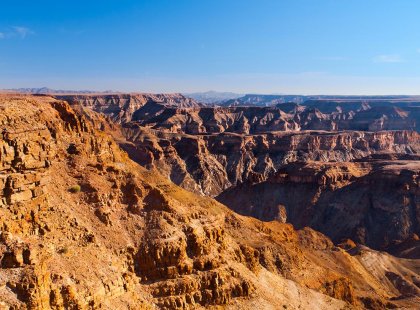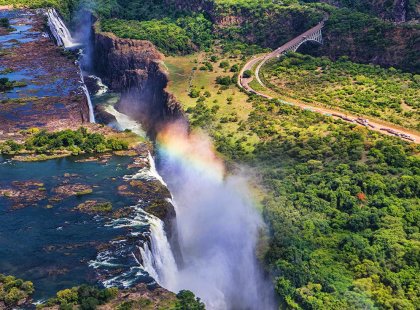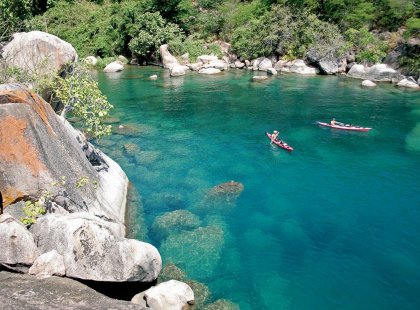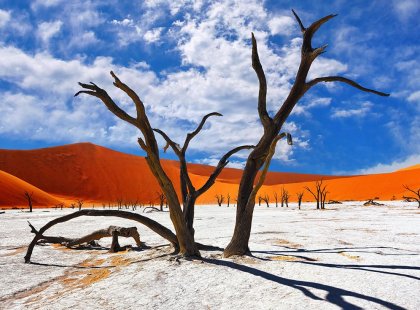Zanzibar to Cape Town
40 days
From
$ 4263
Duration40 days
Explore Africa on an Overland adventure through Tanzania, Zambia, Botswana and South Africa. Travel from Zanzibar to Cape Town through amazing African vistas. Sample the exotic flavours of Spice Island, relax on Kande Beach at Lake Malawi, glide through the Okavango Delta by canoe and keep your eyes peeled for elephants, hippos, crocodiles and lions. This incredible adventure will change the way you see the world.
-
Duration: 40 daysService level: Basic
-
Physical Grading: Light
-
Ages: 15+
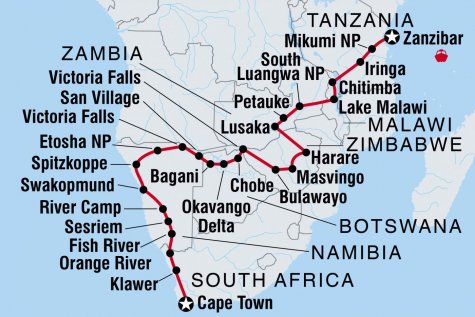
Itinerary
Day 1: Stone Town
Welcome to Zanzibar. Filled with idyllic beaches, winding cobblestone alleyways and fragrant bazaars, Zanzibar has a colourful history – everything from slave traders to Arabian sultans and fruit exporters. The sight of traditional dhows sailing along the coast evokes what the island must have been like in Livingstone's day. The old part of Zanzibar's main city is known as Stone Town. Your adventure begins with a welcome meeting at 2 pm at your Stone Town inn. Please make sure you have your next of kin and insurance details on hand to give to your leader. The best way to see this exotic port town is on foot, exploring the markets, shops, mosques, palaces and courtyards. When the sun is setting, perhaps enjoy a sundowner from a bar overlooking the seafront, and a seafood curry at a local restaurant.
Day 2: Zanzibar Northern Beaches
Check out of your Stone Town hotel and either drive to the spice plantations for your optional guided tour, or head directly to the perfect northern beaches. On the spice plantations guided tour you can learn all about the history of this town's renowned spice trade. You will also have the opportunity to touch, smell and taste various spices, such as cinnamon, vanilla and ginger. Sample some teas made with these spices too. After lunch here you will head to the northern beaches, where white sands and sparkling blue seas await, and reunite with your group. This is the Indian Ocean at its best.
Meals: B
Day 3: Zanzibar Northern Beaches
Enjoy free time in this beautiful archipelago today. There are many ways you can spend your day – perhaps talk to your leader for any recommendations they might have. Snorkelling in search of exotic fish is an excellent option. You might also like to feast on a sumptuous lunch of grilled local seafood, or simply relax in a hammock underneath a coconut tree with a good book.
Meals: B
Day 4: Stone Town
Spend a final morning relaxing on the sandy northern beaches before returning to Stone Town for an afternoon and evening at leisure. Maybe ask you leader where to grab a urojo, an ugly but delicious street treat made from potatoes and noodles stewed in a stock of tumeric, mango, flour and more. Or maybe grab a sugarcane juice and have a wander. You've got a long day of driving ahead tomorrow so make the most of your free time while you can!
Meals: B
Day 5: Mikumi National Park
Embrace an early start to catch a 7.30 am ferry to the mainland, then make tracks for Mikumi. It’s a six-hour drive to your first camp spot, but you’ll get your first look at that famous Tanzanian landscape on the way. Gaze out at vast plains dotted with baobab and tamarind trees and maybe catch a glimpse of some of the elephants, buffaloes, giraffes, lions and leopards that call the park home. Once you arrive at your camp spot, your leader will show you the ropes (literally) and help you set up and get comfortable for your first night in the tent.
Meals: B, L, D
Day 6: Iringa
This morning there is a chance to wake up early and take a 2 hour 4x4 game drive into the Mikumi National Park. Perhaps get a better look at that lion or zeal of zebra you saw from the main road yesterday. Then drive to Iringa (approximately 5 hours). You will set up camp on the grounds of a farmhouse on the outskirts of this pleasant settlement. The area is filled with natural bush land which can make it a bird watchers paradise. Make the most of this rural setting by perhaps doing some stargazing before you retire for the night. Camp facilities, WiFi and accommodation upgrades are available.
Meals: B, L, D
Day 7: Chitimba
Enter Malawi and travel to your campsite at Chitimba (approximately 10–12 hours). Malawi, the 'warm heart of Africa,' is dominated by its lake, which covers almost a fifth of the country and provides a livelihood for many Malawian people. Fishermen, fish traders and canoe and net makers all ply their trade on Lake Malawi. A common sight is that of a fisherman in a bwato (a dugout canoe made from a hollowed tree trunk) fishing on the still lake at the break of day. Camp facilities, WiFi and upgrades are available tonight.
Meals: B, L, D
Day 8: Lake Malawi
Travel from Chitimba to Kande Beach on the shore of Lake Malawi (approximately 6 hours). There will be a chance to stop at a shop or market for any supplies you might need along the way. Enjoy a relaxing getaway from the commercialism and crowds with a few days on the lake's more peaceful beaches. Your campsite at Kande Beach is right on the shore of Lake Malawi. Accommodation upgrades are again possible (subject to availability). There is no WiFi, however.
Meals: B, D
Day 9: Lake Malawi
Enjoy free time to soak up your idyllic surrounds. You might like to participate in one of the many water-based activities on offer – ask your leader for a recommendation. As well as chilling out on the beach, make sure you take the opportunity to meet some local Malawians – easily some of the friendliest people in Africa.
Meals: B, L, D
Day 10: South Luangwa National Park
Journey through southern Malawi and enter Zambia, continuing to South Luangwa National Park (approximately 9–10 hours). There will be border crossing formalities on the way, and a chance to stock up on goods at a shop or market and visit an ATM. The concentration of animals around the Luangwa River and its lagoons is some of the highest in Africa. Take in the beautiful scenery and the abundance of game, watching out for colourful birds and herds of elephants. Your camp tonight has flush toilets, showers and WiFi. Upgrades are also offered (subject to availability).
Meals: B, L, D
Day 11: South Luangwa National Park
Rise early for an exhilirating morning game drive in a 4X4, then head back to the camp for lunch (as this is the hottest part of the day) and then perhaps return to the park for an optional game drive at night. A village walk is another good option, if you'd like a snapshot of daily life in the local community.
Meals: B, L, D
Day 12: Petauke
Head further south to Petauke (approximately 6 hours). The camp tonight has facilities, WiFi and upgrades (availability dependent).
Meals: B, L, D
Day 13: Lusaka
Head for your camp just south of Lusaka city (approximately 6 hours). Arrive, stretch your legs and take a stroll to discover this cosmopolitan yet traditional town. Though it's fast developing, Lusaka retains a strong African feel, and the locals are warm and friendly. Your camp tonight has facilities, a pool and upgrades available. WiFi is not available at this location.
Meals: B, D
Day 14: Harare
Travel to Harare today (approximately 8–9 hours). The first part of your journey takes you to the border with Zimbabwe. After formalities, enjoy a nice scenic drive of 60 kilometres or so, then continue to Harare. There will be a chance to stock up on whatever you need at a market or shop and visit an ATM. Upgrades are available at camp; there is no WiFi, however.
Meals: B, L, D
Day 15: Great Zimbabwe Ruins / Masvingo
Drive the short stretch to Masvingo (approximately 5–6 hours). This colonial settlement – the oldest in Zimbabwe – makes for the perfect base to explore the Great Zimbabwe Ruins. The ruined city, now a UNESCO World Heritage site, was first constructed in the 11th century. It's thought to be the former royal palace of the Zimbabwean monarch. Spend a few hours exploring this intriguing site before heading off to camp. Your campground in Masvingo has shared facilities, with upgrades and WiFi available.
Meals: B, L, D
Day 16: Bulawayo
Travel to Bulawayo (approximately 5–6 hours). Known locally as the 'City of Kings', Bulawayo is Zimbabwe's second largest city. There is some impeccable colonial architecture to take in here. Enjoy free time this afternoon to explore town - a 10 minute walk from the campsite. You might like to browse some local markets or chat with the locals. The Natural History Museum and National Art Gallery are also worth checking out. Tonight you will stay in a campground with shared facilities. Upgrades and WiFi are available.
Meals: B, D
Day 17: Bulawayo
Perhaps get up early and take the option to visit Matobo National Park. Home to a significant population of black and white rhinos, this optional activity gives you the unique experience to track these magnificent animals on foot. Here there will also be the chance to spot other game (the park is home to klipspringers, leopards, warthogs and springhares among many others). while learning about the various local plant and trees, wild pear and paperbark among them. This impressive wildlife park is also the site of the grave of Cecil John Rhodes, the founder of Rhodesia and the De Beers diamond company. The Matopos area has great spiritual and cultural significance to the local people, and there are many sites within the park where important ceremonies still take place.
Meals: B, L, D
Day 18: Victoria Falls
Depart Bulawayo and make the six-hour drive towards Victoria Falls. Stretching 1.6 kilometres wide and falling 108 metres into a narrow gorge below, the falls for which the area is named are truly a sight to behold. Although a visit to the falls themselves is optional, it is highly recommended. The entrance fee to the falls is not included in the price of this trip as groups that book ahead are required to tour the site with a local guide, and we feel that seeing these waterfalls for the first time should be an uninterrupted sensory experience. In the wet season, the spray created from this feat of nature can rise 400 metres and can often be seen from kilometres away. It's no wonder that the local name for Victoria Falls is Mosi oa Tunya, or the 'smoke that thunders'. Though dry season travellers should not despair! You’ll get an unobstructed view of the falls and the chance to see the islets in the river below. Your leader will take you to a local activity centre where a range of activities will be on offer. We have not risk assessed all activities and only those listed in our trip notes are recommended for safety reasons. It is against company policy for leaders to facilitate the booking of any activities that have not been risk assessed or do not adhere to our company’s Responsible Travel policy and ethos. This includes organising transport to and from these activities in our vehicles. If you are interested in the Optional Helicopter flight (12 minutes or 25 minutes) we endorse the following operator only: Zambezi Helicopter co CAA Zimbabwe. Tonight's campground is an ideal base, centrally located in the town of Victoria Falls. Upgrades and WiFi are available.
Meals: B, L
Day 19: Victoria Falls
Today is a free day to enjoy the many activities on offer. If you are interested in the optional helicopter flight (12 minutes or 25 minutes ) we endorse the following operator only: Zambezi Helicopter co CAA Zimbabwe. Your leader can help you arrange this.
Meals: B
Day 20: Victoria Falls
Today is another free day to enjoy the many activities on offer. Or perhaps visit the falls again with your new group members.
Meals: B
Day 21: Chobe National Park
This morning is free for you to continue enjoying all that Victoria Falls has to offer. Afterwards, travel to Chobe National Park in Botswana (approximately 2–3 hours) via the Victoria Falls Wildlife Trust, one of The Intrepid Foundation projects. Here you can learn about the rescue and rehabilitation of wildlife, human-wildlife conflict and the trusts role in anti-poaching. There may also be a chance to meet any rescued or orphaned wildlife currently in their care.
Botswana's first national park is famous for its high concentration of elephants, so keep an eye out for them. They can often be seen swimming in the Chobe River. Your camp, located outside of the park, has flush toilets, showers, Wi-Fi, ATM and optional upgrades.
Botswana's first national park is famous for its high concentration of elephants, so keep an eye out for them. They can often be seen swimming in the Chobe River. Your camp, located outside of the park, has flush toilets, showers, Wi-Fi, ATM and optional upgrades.
Meals: B, D
Day 22: Chobe National Park
Enjoy an early-morning game drive. Adventuring through the park, you will have the opportunity to get up close to the wildlife. With some luck you will spot a variety of animals and any number of exotic birds. As well as the Chobe icon, the elephant, the river also attracts hippos and crocodiles; the latter like to sun themselves by the water's edge. Cheetahs also come down for a drink. The birdwatching is excellent here too – look out for eagles, kingfishers and marabou storks, among hundreds of other species. In the afternoon perhaps take an optional cruise down the Chobe River – one of the best ways to enjoy the park's animals.
Meals: B, L, D
Day 23: Bagani
Today you will enter Namibia, driving from Kasane to Ngoma Bridge, and on to your camp at Bagani (approximately 7 hours). Bagani is a small, friendly town with some good hiking trails along the river. There are also plenty of nice spots in which you can simply relax and soak up the ambience. This area is the homestead of the local Mbukushu kings. You will have the opportunity to stop at an ATM and a market or shop today. Your camp has flush toilets, showers and Wi-Fi. Upgrades are also available (subject to availability).
Meals: B, L, D
Day 24: Okavango Delta
Drive across the border into Botswana and head south along the Okavango Panhandle (the narrowest part of the delta) to Seronga. Here you'll leave your vehicle and join your transport for the journey into the delta (approximately 4 hours). Take a boat across the swamps to Gao Island to meet your mokoro team and start exploring the Okavango Delta with them. Each mokoro (small dugout canoe) takes two people and is poled along through the waterways by a local tribesman. Reeds and lily pads line the streams, and birds startled by the mokoros rise out of the long grasses. Punting along, you'll hear hippos occasionally piercing the peaceful atmosphere with their grunts. On the first night here you'll camp on an island well away from civilisation.
Meals: B, L, D
Day 25: Okavango Delta
Continue your trip around the delta and then return to Gao Island before heading to the relative civilisation of Umvuvu Camp. This camp usually has hot showers, and there's a small bar at which you can relax and perhaps enjoy a refreshing sundowner. Today there is an option to take a nature walk with your guide. This is a great chance to discover the beautiful natural surrounds, gain some insight into the history of the local area and take some photos.
Meals: B, L, D
Day 26: Bagani
Return to Bagani to camp for the night. Various boat trips, fishing trips and guided hikes are possible from Bagani, so if you're feeling active, get out and make the most of it. Those who are feeling bold might even be able to challenge the local kids to a soccer match – don't expect to win though! Retire to your camp in the evening and enjoy this welcome break from the road.
Meals: B, L, D
Day 27: Grootfontein
Drive to your camp situated 50km outside Grootfontein (approximately 7 hours). The town of Grootfontein, part of the Otavi Triangle, tends to get very green in the warmer months but dries out markedly in the winter. If it's springtime, you'll likely see jacarandas in bloom. There is the possibility of an accommodation upgrade here, but wi-fi will not be available.
Meals: B, D
Day 28: Grootfontein/San people
Embark on a 180-kilometre (112-mile) round-trip to visit the San people. The oldest inhabitants of Southern Africa, the San have lived in this region for at least 20,000 years. Listen to their stories and songs, and learn how those who still adhere to a traditional way of life emphasise the important of living in harmony with the environment.
Meals: B, L, D
Day 29: Etosha National Park
Travel about five hours to Etosha National Park. The park is home to a wide range of Southern Africa's wildlife, including all the big carnivores and five rare or endangered species: black rhino, Hartmann's mountain zebra, black-faced impala, roan antelope and the tiny Damara dik-dik. Game viewing in Etosha is relatively easy due to the man-made waterholes and the large, sparsely vegetated pans. The bushland surrounding the pans is difficult to see through, but there are enough clearings, pans and waterholes to usually allow for some sightings. Embark on an optional evening game drive here in the evening, then spend the night at Namutoni. Accommodation upgrades are on offer here.
Meals: B, D
Day 30: Etosha National Park
Enjoy a full-day game drive in Etosha National Park. Namibia has protected its game reserves against poaching, which means significant numbers of elephants, antelope and other herbivores reside here. The park is also home to some 340 species of birds – keep an eye to the sky where you might spot a soaring eagle. Tonight you will stay at the particularly spectacular Okaukuejo Camp. The camp overlooks a floodlit waterhole visited by many different species throughout the day and night. Upgrades are not available at this location tonight.
Meals: B, L, D
Day 31: Spitzkoppe
Travel to the mountain of Spitzkoppe, the 'Matterhorn of Namibia' (approximately 9 hours). The wild lands around this superb granite peak are some of Namibia's most stunning. The mountain itself is 700 million years old and 1987 metres/6519 feet high. Although you shouldn't try to climb to the top, there are some excellent hikes to do in the area, which is rich in plant life and has some bush paintings to be found. Be sure to look out for the sunset from your bush camp this evening – the landscape is known to take on dazzling hues of orange and red.
Meals: B, L, D
Day 32: Swakopmund
Continue to the town of Swakopmund (approximately 5-6 hours). Be dazzled by the sight, sound and smell of thousands of olive-coloured seals on the shores of Cape Cross while you're travelling up the eerie Atlantic Coast. You'll be able to stop along the way to access an ATM or market if you need some supplies. Your accommodation for these nights is a simple, cosy lodge. Wi-Fi is not available at this location.
Meals: B, L
Day 33: Swakopmund
Surrounded by the massive dune fields of the Namib Desert on three sides, and the Atlantic Ocean on the other, Swakopmund is an example of the extraordinary German culture that's found in all major settlements in Namibia. It's worth wandering around town to admire the beauty of the Germanic architecture and take advantage of some excellent souvenir shopping.
Day 34: Swakopmund
Today is another free day to enjoy this fun beachside town. If you're after a dose of history and culture, you can stop in at the lighthouse and visit the Swakopmund Museum. Active types and thrill-seekers might like to take advantage of the many outdoor activities on offer – this town is the adventure-sports mecca of Namibia.
Day 35: Sesriem
Drive to Sesriem, your base for exploring the incredible Namib Desert region (approximately 6-7 hours). The most famous part of the Namib Desert is its vast dune fields, the most spectacular of which are found near the Sesriem Canyon. This canyon was formed when the Tsauchab River carved a gorge 30 metres into the gravel deposits about 15 million years ago. Now the river flows out to the dune fields that stretch for hundreds of miles up the coast, and dries up in a clay pan at Sossusvlei. The dunes are stunning, with magnificent burning tones created by the brightly coloured sands. These are the highest dunes in the world.
Meals: B, L, D
Day 36: Sossusvlei / Konkiep River
Wake up before dawn and scramble to the top of the dunes for a dramatic sunrise view across a vast sea of sand. The colour changes are simply incredible and provide a spectacular setting for your brunch. Afterwards you will jump in the back of a pickup truck for a trip to Sossusvlei, the incredible salt and clay pan just nearby (approximately 30 minutes each way). Enjoy some time to explore this incredible and mysterious desert oddity. Later, continue to your camp past the small town of Bethanie (approximately 6 hours). Your camp has basic facilities, with showers, flush toilets, Wi-Fi and optional upgrades.
Meals: B, L, D
Day 37: Fish River Canyon
Check out the town of Bethanie before heading further south, deeper into the vast desert lands of Namibia, drive towards Fish River Canyon (approximately 3-4 hours). At 500 metres deep and over 160 kilometres long, Fish River Canyon is one of the very largest canyons in the world. During the dry season, the river bed tends to dry out completely, leaving only a few puddles. In the wet season, after the summer rains, the river can turn into a spectacular raging torrent. At any time of year there are remarkable photographic opportunities here as we watch the color of the granite rocks change as the sun goes down. Note that upgrades and Wi-Fi are not available at your camp tonight.
Meals: B, L, D
Day 38: Orange River
Departing Fish River Canyon, travel to Noordoewer (approximately 5 hours). Pitch your tent on the scenic banks of the Gariep (Orange) River. Traditionally known as the Gariep River, the Orange River is the longest in South Africa, at 2200 kilometres/1367 miles. Its source is high up in the Drakensberg mountain range in Lesotho, and it flows into the Atlantic Ocean at Alexander Bay in South Africa. The Orange River is responsible for transporting diamonds and creating the deposits that can be found along the Namibian coast. Upgrades are possible tonight (subject to availability), though there is no Wi-Fi available.
Meals: B, L, D
Day 39: Western Cape
Depart first thing in the morning, heading to Klawer – a town named after the Afrikaans word for a wild clover blooming after rainfall. The surrounding countryside is beautiful. If there's time, you will have the opportunity to explore some of it – take a delightful walk around the nearby mountains and farms before retiring for the evening.
Meals: B, D
Day 40: Cape Town
Head to Cape Town (approximately 5 hours), where you trip ends upon arrival. With its stunning coastline, modern cityscape, nearby mountains and a plethora of nearby vineyards, this is one of Africa's most exciting cities. There's no accommodation provided for tonight, but this can be arranged – please enquire at the time of booking this trip.
Meals: B
Inclusions
Included
- South Luangwa National Park - 4x4 Dawn Game Drive
- Masvingo - Great Zimbabwe Ruins guided visit
- Victoria Falls - Victoria Falls Wildlife Trust Visit
- Chobe National Park - Dawn 4x4 game drive
- Okavango Delta - Mokoro safari
- Okavango Delta - Nature Walk
- Grootfontein - San Bushman cultural experience
- Etosha National Park - Overland Vehicle Game Drive
- Cape Cross Nature Reserve - Cape Cross seal colony
- Sossusvlei - 4x4 Tour
- Sesriem - Sand dunes visit
- Fish River Canyon - Canyon entrance
-
Transport
Overland vehicle, 4x4 Safari Vehicle, Ferry, Minibus, Mokoro -
Accommodation
Camping (with facilities) (28 nights), Camping (with basic facilities) (2 nights), Bungalow (2 nights), Chalet (3 nights), Hotel (3 nights)


